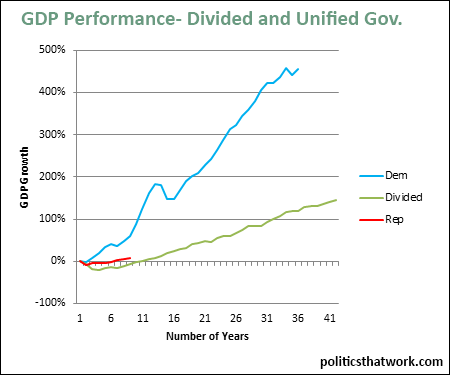GDP Growth Since 1930 During Years with Unified and Divided Government
Description: This graph shows the annual change in the GDP of the U.S. for every year since 1930. The years are broken out into years when the House, Senate and White House were all controlled by Democrats, years in which they were all three controlled by Republicans, and years in which control was split between the parties. The growth is graphed as if the years attributed to each category occurred back to back without the intervening years having occurred.
Discussion: During the 35 years since 1930 when the Democrats have had unified control of the federal government, if those years were back to back, the GDP would have grown approximately 450% while in the 41 years that we've had divided control, the GDP would have grown less than 150%.
One way to estimate the economic cost of gridlock, obstruction, and brinksmanship is to compare how our GDP grows during years when the Democrats control both houses of the legislature and the executive branch with the GDP growth during years when the Republicans control at least one of the houses of the legislature or the presidency. The area between the blue line and the green line in this graph gives one a rough idea of the scale of the economic damage.
The reasons that the economy grows so much more slowly when Republicans have partial control are certainly up for debate, but candidates would include the uncertainty that brinksmanship creates- such as the damage to the market when the Republicans threatened to default and did shut the government down, the reduction in the government's ability to adapt to changing circumstances when it is gridlocked, and the obstruction of what may be more sound Democratic policy.See more graphs about: GDP
